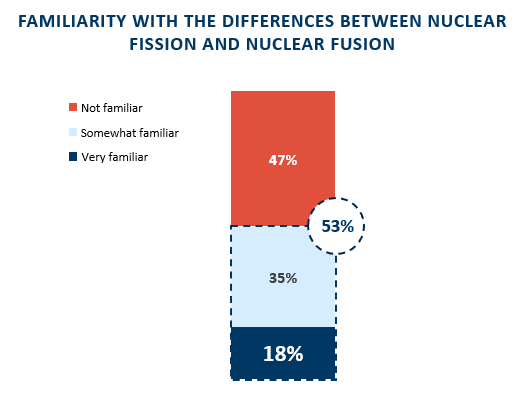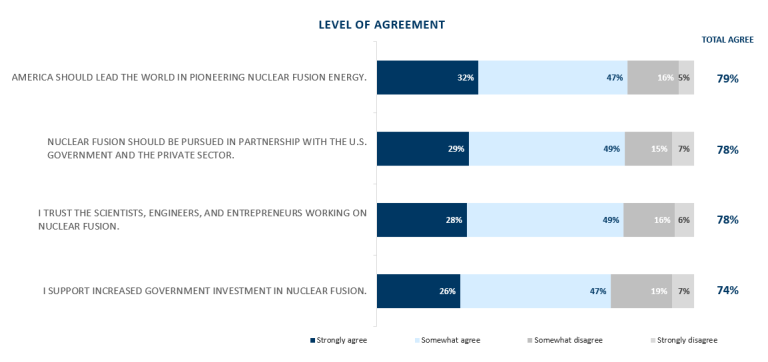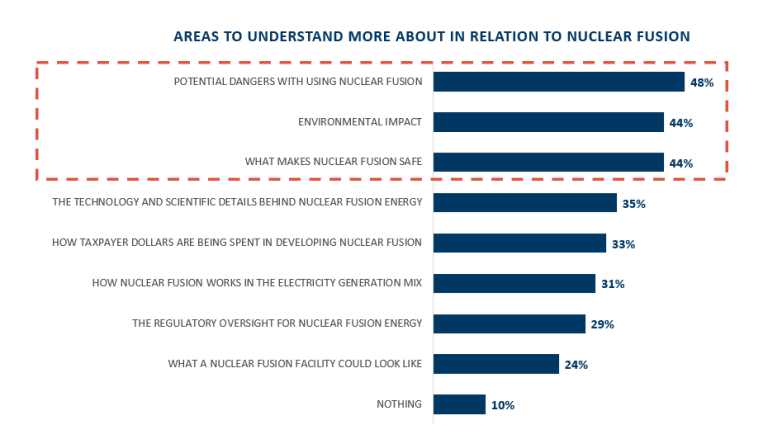Americans’ Fusion Energy Favorability Creates Narrative Defining Opportunity
Americans are upbeat and intrigued at fusion energy’s promise but need more information as the technology advances, a nationwide public opinion survey conducted by FTI Consulting details.[1]
As billions of dollars in private and public capital move into the three dozen private companies racing to achieve the elusive fusion commercialization target, the language the industry employs and its ability for sustained education and advocacy will be primary factors in achieving the sector’s commercial goals.[2]
How Americans View Fusion – Key Findings[3]

Despite the hype around fusion technology, most experts predict early-to-mid-2030s commercialization, with significant scientific hurdles remaining.[4] As we explored in this May 2023 (“Nuclear Fusion’s Non-Scientific Pathway to Commercialization”), this long-development tail presents unique communications and public affairs challenges as the technology remains just a promise.[5]
“There is a graveyard littered with over-promises, missed milestones and false starts,” Benj Conway, co-founder and president of Zap Energy told TechCrunch[6] “The basic physics of fusion is real, the potential upside is real, but to shed its baggage, the industry needs to deliver more than promises and concepts.”
Mr. Conway is right. Over the next decade, some companies will make it, some experiments will trigger the next breakthrough; while others will fail spectacularly and targets will be widely missed. Critics will inevitably seize on the failures, the over-promises and under delivery – and those voices will get louder as each day passes toward projected 2030s commercialization.
For the fusion industry, as well as individual companies, media coverage trends and survey data confirm the importance of a sustained, integrated communications strategy aimed at defining the language (i.e. more “fusion” less “nuclear fusion”), managing expectations, and using quality, in-depth content to educate key stakeholders in D.C. and financial communities.
How Americans View Fusion Today
Low familiarity with fusion provides an opportunity to define the narrative as fusion becomes commercially viable and begins to emerge into the public consciousness.
Around half of voters are not familiar with the difference between fusion and fission. Though slightly more than half report being at least somewhat familiar, only 18% say they are very familiar; many of the remainder have likely heard the word “fusion” and may be vaguely familiar with what it entails, but are far from experts and may confuse it with other concepts.[7]

Figure 1. Findings based on FTI Consulting survey (See endnote 1).
Lower familiarity implies that public opinion is not well-established, with most voters lacking any preconceived opinions about fusion. However, as fusion becomes an increasingly viable energy source in the coming years, this will change. The next few years present a short window of opportunity for proponents of fusion to proactively define the narrative.
Despite low familiarity, most voters support the development of fusion energy, even after hearing critiques.
Upon being presented with a brief definition of fusion and its potential as an energy source, nearly three-quarters of voters expressed support for fusion energy development – including nearly three in 10 who strongly support it. Most of those who aren’t currently strong supporters could be convinced, with only a small minority of 3% saying they are strongly opposed.[8]

Figure 2. Findings based on FTI Consulting survey (See endnote 1).
Even though opposing arguments* impact support for fusion, a majority of 67% still support fusion development despite this critique. Furthermore, the impact on the share of voters who strongly support or oppose fusion was negligible.[9]
*Note: The critique voters evaluated in this case argued for increased support for existing zero carbon technologies rather than unproven energy sources like fusion.[10]
Figure 3. Findings based on FTI Consulting survey (See endnote 1).
Furthermore, large majorities of voters support increased investment in fusion, trust the scientists, engineers, and entrepreneurs working in the space and want to see America leading the world in developing fusion energy.[11]


Figure 4. Findings based on FTI Consulting survey (See endnote 1).
The language used around fusion energy will be key to reinforce support and will inevitably have an impact on perceptions, underscoring the need to be careful and forward-looking in designing any messaging and campaigns.
Consistent with lower familiarity among the voting public, there is no single word or phrase that is universally associated with fusion*. However, words like “radioactive” and “dangerous” are more likely to be associated with fusion. Other common (and more positive) associations include “clean”, “sustainable”, and “efficient”.[12]
The survey was designed such that some respondents saw questions asking about “nuclear fusion” while some saw a slightly different phrasing, with questions asking about “fusion”. Those who saw only the word “fusion” were more likely to associate fusion energy with being “clean”. On the other hand, mentioning the word “nuclear” conjures more negative associations. Those who saw “nuclear fusion” were significantly more likely to associate it with “radioactive”, “dangerous”, and “meltdown”.[13]
De-emphasizing the word “nuclear” is one way to disassociate fusion with negative concepts originating in concerns about nuclear fission and to cultivate more positive perceptions. That being said, it is not a panacea by any means and more must be done to improve the public perception of fusion.
*Note: Survey respondents were exposed to a definition of nuclear fusion only after selecting what words they associate with the concept.[14]

Figure 5. Findings based on FTI Consulting survey (See endnote 1).
Any potential education campaign should strive to address voters’ legitimate concerns and lack of knowledge around fusion.
Many voters express a willingness to learn more about nuclear fusion, but are primarily focused on questions around safety, including the potential dangers of using nuclear fusion, its environmental impact, and what makes it safe. They are less interested in learning about more technical details on the science of fusion, what’s being done to regulate the industry, or how taxpayer dollars are being spent.[15]

Figure 6. Findings based on FTI Consulting survey (See endnote 1).
Additionally, the idea that fusion research and development is taking away resources from other carbon-free sources of energy resonates with many voters.[16] Emphasizing that energy development is not a winner-take-all scenario, while also focusing on the immense benefits of viable fusion energy may help to reverse this perception.
Any messaging should also address how fusion will impact the communities where it is produced. Four in 10 voters would not be comfortable with a fusion facility in their community;[17] though this lack of comfort may naturally decline as voters become more knowledgeable about fusion, it is important to directly address these concerns in addition to providing general education on the topic.

Figure 7. Findings based on FTI Consulting survey (See endnote 1).
Fusion Industry’s Next Move?
Focus today on the key stakeholders and markets. Anecdotal evidence, survey data and media trends point toward Washington – at this early stage, lawmakers and regulators need to get smart on the science to realize the opportunity fusion holds to advance funding and regulatory policies conducive to growth. Deeper quantitative and qualitative research inside the Beltway can help the industry key in on specific language and messages; establishing a strong foundation for a public affairs campaign.
A sustained communications strategy centered on defining language and shaping media narratives is an important space for the industry to collectively focus its efforts. Individual companies should advance their own science, financial raises, and achievements, and the broader industry’s role is to elevate successes, advocate for smart policy, and educate on progress.
Make no mistake, fusion energy is at an important juncture and the window of opportunity is now for the industry to educate and set a narrative that’ll define fusion’s trajectory for decades to come.
[1] FTI Consulting survey: This research was conducted by FTI Consulting’s Digital & Insights team, among a representative sample of N=2,000 likely voters in the 2024 presidential election in the United States. N=1,001 respondents were shown questions that included the phrase “fusion”, while N=999 respondents saw questions that included the phrase “nuclear fusion”. All research was conducted between the dates of July 17 – July 26, 2023, with responses being collected both online and by phone. Per the standard convention of rounding, some totals may not add up to 100%. For questions, please contact james.condon@fticonsulting.
[2] “Fusion Industry Investment Passes $6bn,” Fusion Industry Association (July 12, 2023), https://www.fusionindustryassociation.org/fusion-industry-investment-passes-6bn/.
[3] See supra note 1.
[4] Tim De Chant, “7 founders and CEOs discuss fusion power’s most pressing challenges,” TechCrunch (August 24, 2023), https://techcrunch.com/2023/08/24/fusion-power-challenges-founder-survey/.
[5] John Sutter, Wells Griffith and Lilya Nguyen, “Nuclear Fusion’s (Non-Scientific) Pathway to Commercialization,” FTI Consulting (May 22, 2023), https://fticommunications.com/nuclear-fusions-non-scientific-pathway-to-commercialization/
[6] See supra note iv.
[7] Findings based on FTI Consulting survey (see supra note 1).
[8] Id.
[9] Id.
[10] Id.
[11] Id.
[12] Id.
[13] Id.
[14] Id.
[15] Id.
[16] Id.
[17] Id.
The views expressed in this article are those of the author(s) and not necessarily the views of FTI Consulting, its management, its subsidiaries, its affiliates, or its other professionals.
©2023 FTI Consulting, Inc. All rights reserved. www.fticonsulting.com



